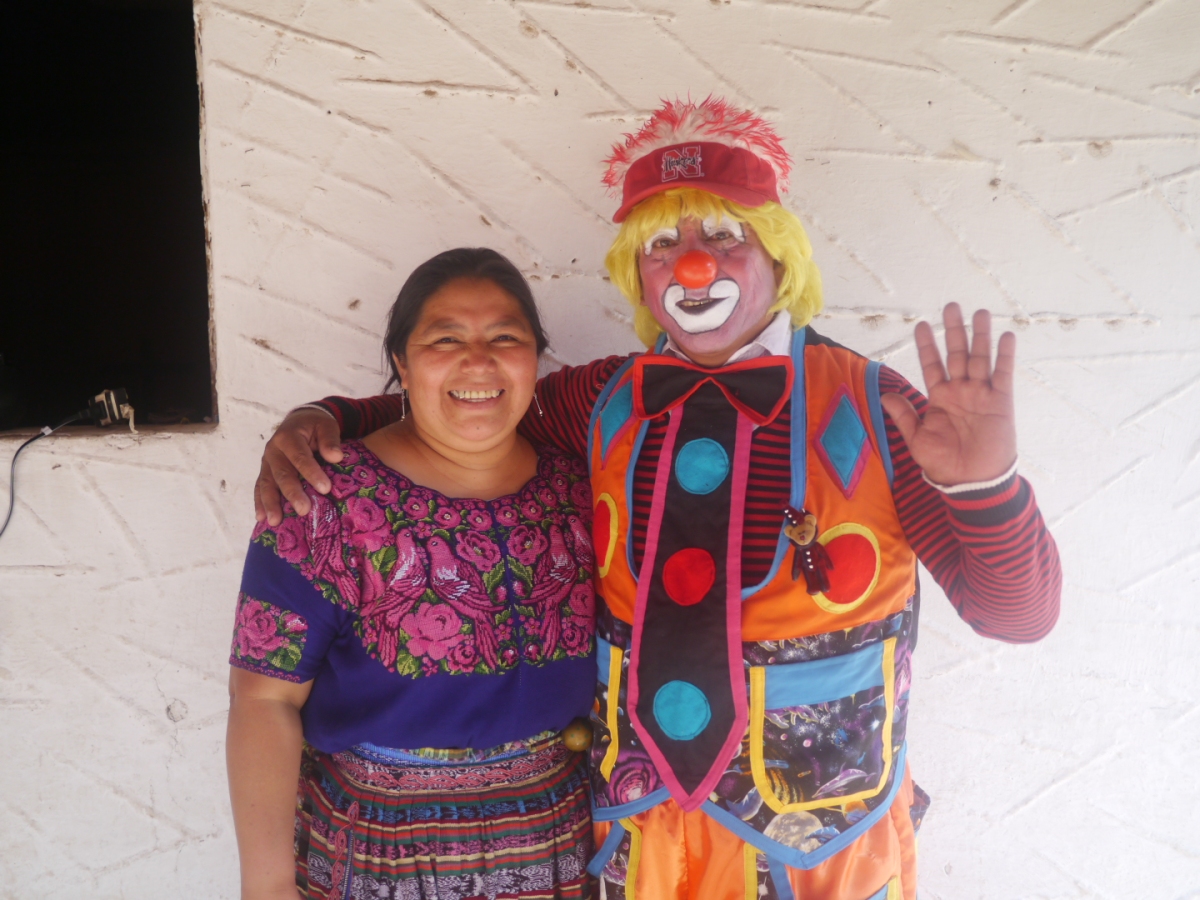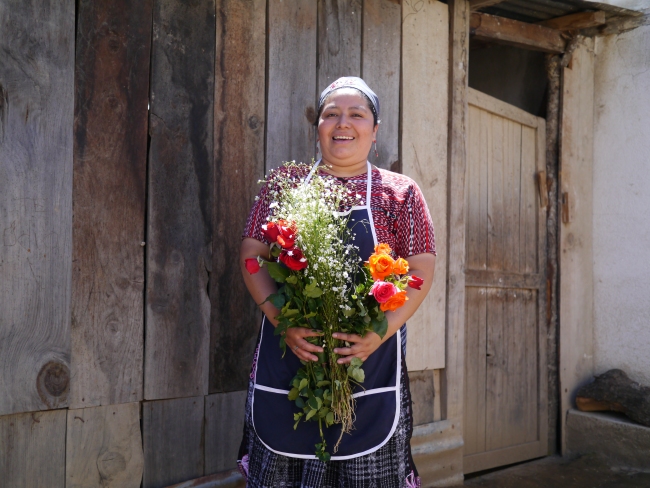Record Holders 2012
42K Winners
Kristina Margarita Milne————————–3:38:22
Javier Isaac Turnil Ixquiac———————–3:09:31
21K Winners
Laura Co Torres—————————————1:35:36
Diego Ajtzalam—————————————–1:14:45
traducción al español a continuación
Mayan ladies in traditional dress watched an international field of competitors trek past their doorways. It looked like the entire pueblo of Panajachel stepped out to cheer on the extraordinary racers. School kids sporting “Marathon Atitlan” headbands handed out Gatorade, some young men, in rain gear, directed the runners onto the narrow road up. The Federal government contributed a CONRED truck as an escort and, all along the route, cars and tuk-tuks skulked to a virtual stop. Traffic was held up behind the convoy of support vehicles. What was especially nice was that the chicken buses were obliged to withhold their inky plumes from the athletes.
More than three hundred participants signed up to negotiate one of the two lanes spanning the steep hills above Lake Atitlan. Sixty-six stalwart women entered the Half and one 70 year old completed in a very respectable time.
Women 65+
21K Nancy Pullo ———–3:03:38
There were a eleven women competing in the Full.
The title “Extreme” applies because the volcanic caldera slopes at such sharp angles – like a coffee filter. In some places, it rises/falls more than 2,000 feet in under a mile. One wheel-chair bound “Achilles” runner, J.C.Perez, covered some of the steepest down-hills backwards. Maybe he does this because he brakes better. Maybe he does it by “feel” rather than looking. One runner told me she caught his eye as he rolled (face first) downhill and barely made a “very lucky swerve” avoiding a steep fall. This formidable competitor tackled both races this weekend. He finished the Half in 4:22:08. On Sunday, he started the Marathon 2 hours ahead of everyone because he did not want to be last – J.C.Perez finished the Full in 7:27:47
If the course was tough, at least the weather favored the runners. As race week started, NOAA reported tropical storms off both Pacific and Atlantic coasts and the maps showed very few breaks in the soggy lace of clouds. The morning of the Half Marathon the soaking let up just as people had to enter the chutes. Fortunately, both races were run under a thick, cool cloud cover. In some places, the field had wide pools of water under foot but, hey, this is an Extreme Marathon.
Many of the runners were Guatemalan; some made the three hour trek up from the Capital others came from nearer by in the Highlands. There were comparably trained runners from mountainous, high altitude Colorado. But, we were most delighted to see some of our Mayan neighbors, competing on their own turf and leading the pack. There were some senior men, who completed both races back to back. One of them, Efrain Elias Ramirez Velasquez a sixty three year old from Panajachel, won his age group with a good margin in both races.
Men 60 – 65
42K Efrain Elias Ramirez Velasquez —–4:06:39
21K Efrain Elias Ramirez Velasquez —–1:53:41
This Marathon was the idea of a local runner, who wanted to stimulate the community’s economy during the rainy season. Somehow, he mobilized this resort town of retired ex-pats, NGO workers and Indigenous people. He tapped a local group to find sponsors. Then, he set about getting the race course officially sanctioned; measured and marked. Finally, he set about to train to win his age division – which he did.
MEN 66+ –
Richard John Morgan-Szybist —–5:42:24.0
Richard can be proud of this win and for planting the seeds that grew into this Marathon. It was wildly successful in engaging the whole town – together. Business boomed and everyone enjoyed the sporty visitors and their families. Lots of local people are so inspired they are talking about training up for next year… or at least starting a volley ball team.
________________________________
Las damas en trajes tradicionales mayas vieron un campo internacional de los competidores de caminata más allá de sus puertas. Parecía que todo el pueblo de Panajachel salió para animar a los corredores extraordinarias. Niños de la escuela deportiva “Maratón de Atitlán” bandas para la cabeza entregó Gatorade, algunos hombres jóvenes, en las artes de la lluvia, dirigida a los corredores a la calle estrecha hacia arriba. El Gobierno Federal aportó un camión CONRED como un escolta y, a lo largo de la ruta, coches y tuk-tuks acechaba a una parada virtual. El tráfico se mantuvo detrás de la caravana de vehículos de apoyo. Lo que era especialmente bueno fue que los autobuses de pollo se vieron obligados a suspender sus plumas manchadas de tinta de los atletas.
Más de trescientos participantes firmaron para negociar uno de los dos carriles que atraviesan las empinadas colinas por encima del lago de Atitlán. Sesenta y seis mujeres de carácter entraron en la mitad y uno de 70 años completó en un tiempo muy respetable.
Las mujeres de 65 +
21K Nancy Pullo 03:03:38
Había menos de una docena de mujeres inscritas en el pleno.
El título de “Extreme” se aplica debido a que las pistas de caldera volcánica en ángulos tan agudos-como un filtro de café. En algunos lugares, se sube / baja de más de 2.000 metros en menos de un kilómetro y medio. Uno en silla de ruedas “Aquiles” corredor, JCPerez, cubierto algunas de las más escarpadas de las colinas abajo hacia atrás. Tal vez lo hace porque frena mejor. Tal vez lo hace por la “sensación” en lugar de buscar. Un corredor me dijo que le llamó la atención, como laminados (primera cara) hacia abajo y apenas cometió un “viraje muy afortunado” para evitar una fuerte caída. Este formidable competidor abordado las dos carreras este fin de semana. Terminó la mitad de 4:22:08. En domingo, comenzó la maratón de 2 horas por delante de todos, porque él no quería ser el último.
Si el curso fue duro, por lo menos el clima favoreció a los corredores. Como semana de la carrera comenzó, la NOAA informó de las tormentas tropicales de ambas costas del Pacífico y Atlántico y los mapas mostraban muy pocas pausas en el encaje empapado de nubes. La mañana de la Media Maratón de la maceración que justo cuando la gente tenía que entrar en las rampas. Afortunadamente, las dos carreras se realizaron bajo una gruesa cubierta, nube fresca. En algunos lugares, el campo tenía remansos de agua bajo sus pies, pero, hey, esto es un maratón de Extreme.
Muchos de los corredores eran de Guatemala, y algunos hicieron la caminata de tres horas a partir de las demás capitales vinieron de cerca por los de las Tierras Altas. Había corredores con una formación comparable de montaña, la altitud de Colorado. Pero, fueron los más felices de ver algunos de nuestros vecinos mayas, compitiendo en su propio territorio y a la cabeza. Había algunos hombres mayores, que completaron las dos carreras espalda con espalda. Uno de ellos, Efraín Elías Ramírez Velázquez un sesenta y tres años de edad de Panajachel, ganó su grupo de edad con un buen margen en las dos carreras.
Los hombres de 60 a 65
42K Efraín Elías Ramírez Velásquez 04:06:39
21K Efraín Elías Ramírez Velásquez 01:53:41
Esta Maratón fue la idea de un corredor local, que quería estimular la economía de la comunidad durante la temporada de lluvias. De alguna manera, que movilizó a esta ciudad turística de jubilados expatriados, trabajadores de ONG y personas indígenas. Se tocó un grupo local para encontrar patrocinadores. Luego, se dedicó a conseguir el campo de regatas oficialmente sancionada, medido y marcado. Por último, se dedicó a entrenar para ganar su división de edad – lo que hizo.
HOMBRES 66 + –
Richard John Morgan-Szybist 5:42:24.0
Richard puede estar orgulloso de esta victoria y para la siembra de las semillas que crecieron en este Maratón. Fue un gran éxito en la participación del pueblo entero – juntos. El negocio floreció y todos disfrutamos de los visitantes deportistas y sus familias. Muchos de los habitantes locales están tan inspirados que están hablando de la formación para el próximo año … o al menos a partir de un equipo de voleibol.
Link to Race Results and information on next year’s race
This slideshow requires JavaScript.






















